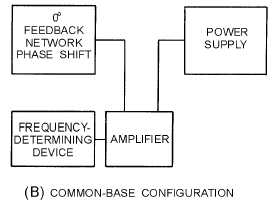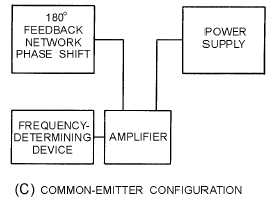2-10
Figure 2-8B.—Basic configurations. COMMON-BASE CONFIGURATION.
Figure 2-8C.—Basic configurations. COMMON-EMITTER CONFIGURATION.
COMMON-COLLECTOR CONFIGURATION
Since there is no phase reversal between the input and output circuits of a common-collector
configuration, the feedback network does not need to provide a phase shift. However, since the voltage
gain is less than unity and the power gain is low, the common-collector configuration is very seldom used
in oscillator circuits.
COMMON-BASE CONFIGURATION
The power gain and voltage gain of the common-base configuration are high enough to give
satisfactory operation in an oscillator circuit. The wide range between the input resistance and the output
resistance make impedance matching slightly harder to achieve in the common-base circuit than in the
common-emitter circuit. An advantage of the common-base configuration is that it exhibits better high-
frequency response than does the common-emitter configuration.
COMMON-EMITTER CONFIGURATION
The common-emitter configuration has high power gain and is used in low-frequency applications.
For the energy which is fed back from the output to be in phase with the energy at the input, the feedback
network of a common-emitter oscillator must provide a phase shift of approximately 180 degrees. An



